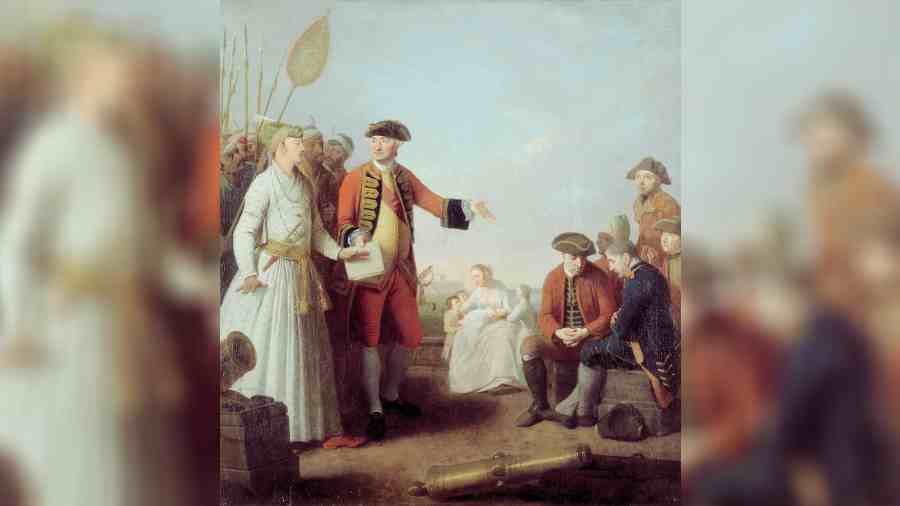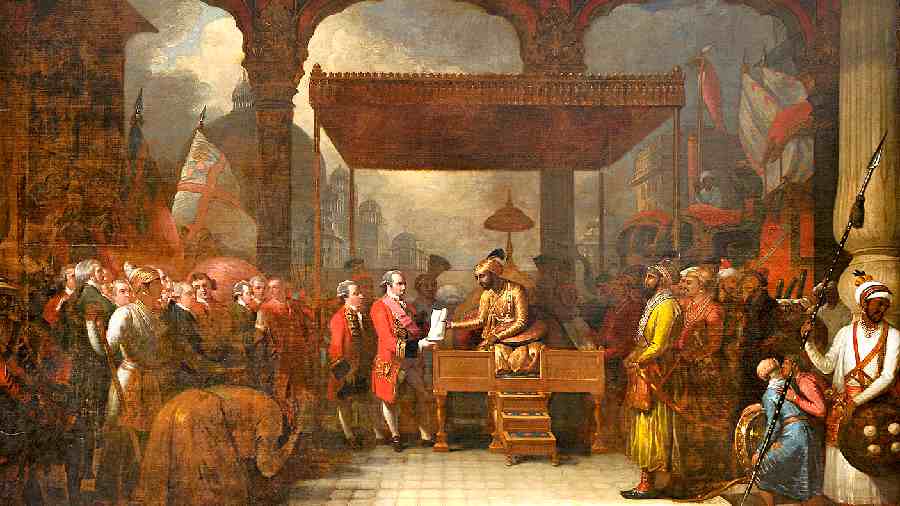“This looks nothing like him,” said Jennifer Howes, pointing to the slide of a painting. The former visual curator of the British Library was giving a talk titled “Robert Clive in British Art” at Calcutta’s Victoria Memorial Hall. The painting by British artist Francis Hayman shows Clive meeting Mir Jafar after the Battle of Plassey.
At the time, Clive would have been 32 and a lieutenant governor in the British Army.
For the talk, Howes had picked representations of the infamous imperialist from 1760, 1764, 1772 and 1795. Clive died in 1774, aged 49, which means many of the paintings and sculptures were completed in his lifetime.
To get back to the Hayman, the rest of the scene seemed authentic enough. But according to Howes, the Clive of this particular canvas was “much too handsome” and a “sentimentalised” figure. She said, “Hayman’s painting played upon the emotions that helped make Clive a household name. It was designed to evoke nationalist sentiments in Britain that praised the emergence of an international empire with London at its centre.” Oddly enough, Hayman had never been to India but it is unlikely that he would have been unaware of what Clive looked like.
The years of completion of the paintings chosen by Howes correspond to milestones in Clive’s life and career. See for yourself.
In 1760, he left for England, his tenure as Governor of Bengal behind him, his pockets overflowing with riches.
By 1764, he had already been knighted, was an MP and, thereafter, on his way to govern Bengal for a second time.
In 1772, East India Company was almost bankrupt and the British Parliament started inquiring into the conduct of Company officials in Bengal and Clive’s role as well. That year in March, addressing the House of Commons, Clive said:“…far from reaping any benefit myself from the expedition, I returned to England many thousand pounds out of pocket.”
The Hayman painting was commissioned by Jonathan Tyers and was on display at London’s Vauxhall Gardens — the 18th century amusement park owned by him. The East India Company’s shareholders had voted unanimously to have Flemish sculptor Peter Scheemakers make a statue of Robert Clive. It was commissioned in 1760, the same year that Hayman’s work was completed. Scheemakers’ sculpture of Clive as a Roman general was displayed inside the largest public area of London’s East India House, the General Courtroom. “It has to do with imperial Rome being seen as a model for East India Company’s conquests,” said Howes.
The Plassey painting as well as Scheemakers’ work belonged to a period when Clive’s star was ascendant. Edward Penny’s painting, done between 1770 and 1772 and showing Clive founding the East India Company’s pension scheme, is different in that it was meant to be a corrective.
When Clive returned to England in 1769, his wealth is said to have been between £2,70,000 and £3,00,000. This was in addition to an annual income of £27,000 from the jagir for which he had solicited Mir Jafar. He bought vast tracts of land in Wales, palladian townhouses in London and Bath, and country homes in Shropshire and Surrey. “He arranged for Claremont, his estate in Surrey, to be completely redesigned and there was a lot of public speculation about how much cash Clive had poured into these projects,” said Howes. When Bengal writhed in the grip of a sweeping famine, Clive and the East India Company were criticised for their role in emptying its coffers at the cost of filling their own pockets. Howes continued, “The British public turned against him.”
The Company’s pension scheme, also known as Lord Clive’s Fund, was the first corporate pension to be established in London. It was meant to financially assist old and disabled East India Company soldiers in Britain, and soldiers’ widows and orphans. In Penny’s painting, Clive is shown clutching in his right hand a document — it is the warrant for the Nawab of Bengal’s legacy, which funded the pension scheme.

Clive receiving from the Nawab of Bengal the grant for Lord Clive’s Pension Fund. Oil painting by Edward Penny. Pictures: British Library London, F29 and F91.
According to Howes, the painting shows that the Company was clinging to Clive’s earlier image as their hero, the poster boy of the Empire. It might have been commissioned to help heal Clive’s deteriorating image.
The only artwork that was part of Howes’ talk but not completed during Clive’s lifetime was a Benjamin West painting. It shows Mughal emperor Shah Alam II conveying the grant of the Mughal diwani to Clive in 1765. Mind you, Clive himself had commissioned this work around 1770 and intended it to be displayed inside the dining room of Claremont, his country house in Surrey. When he died in 1774, work on the painting stopped. The canvas remained with the Clive family till in 1795 it was completed by West. Clive’s son Edward gave the painting to the East India Company in 1820.
In 1821, the painting was installed in East India House. Those days, East India Company was changing from a mercantile venture to a bureaucracy. Said Howes, “So for East India Company, this painting of Clive visualised this new administration. It crystallised this moment that they identified as when it symbolically took administrative control of India.”
And that’s how rulers rule, always and everywhere — with a lot of art and a spot of statecraft.











